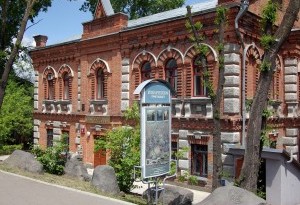Archeological Museum, Khabarovsk

Journey into the distant past of the Khabarovsk Territory begins already at the entrance to the museum of archeology: on the slope of Turgenev street there are stones with copies of the most ancient rock paintings of Sikachi-Alyan. The plots are mostly zoomorphic: these animals and birds lived in the Amur region of the Late Ice Age. On other stones carved images of people in boats and anthropomorphic masks - scientists associate them with shaman practitioners.
The museum of antiquities is very young. It opened in 1998 as a branch of the Khabarovsk Regional Museum, the basis of its collection was the collection of the outstanding Siberian archaeologist A.P. Okladnikov. The museum is located in the former mansion of Bernard Lübben, the owner of one of the first Khabarovsk breweries. The brewery is also preserved, stands right behind the mansion. Both buildings are listed in the register of cultural heritage sites.
Today, the museum has more than 160 thousand exhibits. The most valuable are the Paleolithic collection and weapons of the Jurchen people found on the territory of the region. These are dry facts behind which there is something unexpected and very interesting: experimental archeology.
Roughly speaking, one can for a long time build up theories about the methods of using and the technicality of stone axes, but you can learn how to make these same axes and study the labor costs of a prehistoric logger in practice. This is experimental archeology, which the Khabarovsk Museum willingly supports. Artifacts from excavations on the territory of the region make up only half of its exhibits. The rest is skillful reconstruction. And we must admit that reconstruction is often much more interesting than genuine objects. It is difficult for a non-specialist to be seriously interested in the medieval lamellar shell of Jurchen tomb, assembled as a mosaic from several dozen rusty pieces of iron. Whether the case is a model of a Neolithic village or the only exhibit on the first floor of the museum is a full-size reproduction of a primitive dwelling. The already mentioned process of cutting trees is revealed on a special stand in all details - from the manufacture of a stone ax to the subtleties of its use.
Some archaeological experiments can be done by the visitor himself. The ax will not be given to him, but they will offer to create a pot or an earthenware bowl. Without a potter's wheel, according to the most ancient method: strips of clay are stuck on the bottom of the vessel around the circumference one by one until the walls grow to the desired height. A homemade vase can be taken with you. Only it is worth considering: in order for the vessel not to fall apart, it must be thoroughly dried and burned in a special oven.
Join our tours and take a look at this amazing attraction:
Excursions - www.uvisitrussia.com/day-tours/tours-to-siberia-and-far-east/
Tours - www.uvisitrussia.com/tours-to-siberia-and-far-east/



